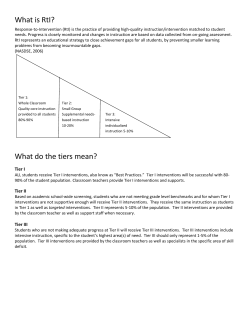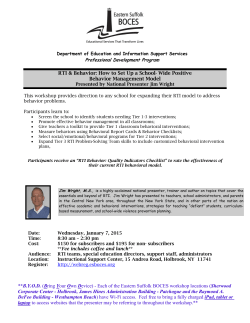
How to Fit Response to Intervention Into a Heavy Workload
August 30, 2011 ASHA Leader How to Fit Response to Intervention Into a Heavy Workload by Judy Rudebusch & JoAnn Wiechmann Response to intervention (RTI) is the practice of ensuring there are systems in place in general education to help every student meet grade-level expectations in academics and behavior. The essential components of an RTI system include (NASDSE, 2005): High-quality instruction and learning opportunities matched to student need. Identification of students struggling to meet grade-level expectations. Attention to students' learning rate and level of performance. Increasing intensity of instruction/intervention based on student needs. Data-informed educational decisions using a team problem-solving method. Speech-language pathologists have important roles and responsibilities in RTI frameworks. Speech-language pathology practice in schools has evolved to emphasize service delivery that is grounded in grade-level curriculum and the Common Core State Standards (2010). This focus on literacy and providing just-in-time assistance for students is emphasized in the ASHA document Roles and Responsibilities of Speech-Language Pathologists in Schools (2010) and is a natural fit for the specialized knowledge and skills of the school-based SLP. Perhaps the most significant challenge for the SLP involved in RTI activities is incorporating general education roles and responsibilities into an already full caseload. Using a workload approach (ASHA, 2002) provides the impetus for RTI activities to become integral to the array of services provided rather than an "add-on" or optional set of activities. The workload approach starts with an analysis of all responsibilities and activities necessary to provide appropriate services, and then assigns staff based on that analysis. Using a workload approach allows the SLP to make consistent, systematic, and student-centered decisions about whom, how, how long, and where to serve, and what context to use for services. The roles of the SLP in RTI are to provide direct and indirect intervention services designed to prevent placement in special education when interventions through general education are sufficient to assist the student, and to provide early identification of communication disorders that warrant specially designed instruction through an Individualized Education Program (IEP). Thus, the SLP's involvement in prevention activities and early identification practices is required, not optional (see Figure 2 [PDF]). Embedding RTI in a workload approach brings together two powerful concepts that can improve quality of service for students who struggle to meet grade-level or course expectations. Key leverage points for embedding RTI in a workload approach include considerations of educationally relevant services, a continuum of service delivery models, flexible scheduling, data-driven decisions, and advocacy and leadership roles for communicating a change in SLPs' roles and responsibilities. Educationally Relevant Services Educationally relevant speech-language services are grounded in grade-level standards reflected in the general education curriculum, and in working with students on speech, language, and communication skills needed for high levels of performance in academics and behavior. The Common Core State Standards (2010)—the result of an initiative led by the Council of Chief State School Officers and the National Governors Association—are a synthesis of the standardsrelated work to date and provide a common set of standards that are rigorous, research- and evidence-based, aligned with college- and career-readiness standards, and internationally benchmarked. Viewed through this lens, the SLP's role in RTI also revolves around supporting students in mastering the common core standards in areas that overlap with speech and language skills. Thorough knowledge of the common core standards is a critical component of current speech-language service delivery. Continuum of Service Delivery Models Service-delivery models in school contexts include direct and indirect speech-language services and activities that can be provided as pull-out, classroom-based, community-based, or selfcontained classroom services (Cirrin et al., 2010). The most commonly used service-delivery models in RTI provide direct and indirect classroom-based services for Tier 1 supports, and pullout for Tier 2 or Tier 3 focused intervention. Given that the intent of Tier 1 instruction is to provide all students with a scientifically based curriculum that follows state or core standards, the primary role of the SLP at Tier 1 is to provide indirect services that support students in the curriculum. An SLP providing Tier 1 services, for example, could: Provide information for parents and teachers regarding speech and language development. Plan and develop lessons on effective language and communication skills within the context of the classroom curriculum. Provide professional development on language-to-literacy connections (e.g., phonological awareness, vocabulary, language structures, verbal reasoning). Collect data during classroom observations on students' speech and language skills or language demands during instruction/delivery of the curriculum. Design and facilitate homework programs to target speech-language skills. Highlight language development connections in the curriculum. Direct services at Tier 1 can include conducting expanded speech and language screenings to identify students for Tier 2 or Tier 3 speech or language interventions, modeling lessons for teachers that target effective language and communication skills within the context of the classroom curriculum, or providing lessons that bridge speaking, listening, reading, and writing through the use of narratives. Tier 2 is designed for students who are performing below grade-level standards. Tier 2 interventions often are provided in the form of targeted small-group instruction using evidencebased practices to address specific student weaknesses. Tier 2 interventions are provided in addition to the services and instruction provided at Tier 1. The targeted small-group instruction is provided by skilled teachers and/or specialized professionals. Speech-language interventions at Tier 2 may include both indirect and direct services. An SLP providing indirect services may: Assist in selection of evidence-based practices for literacy interventions. Identify, use, and disseminate evidence-based practices for math, reading, listening, speaking, and writing. Serve on the campus intervention team. Observe Tier 2 students to identify when their struggles are linked to speaking, listening, reading, or writing and to assist in collecting additional data to drive decision-making. Communicate Tier 2 progress to teacher/parent. An SLP providing direct services may: Provide small-group articulation intervention. Provide small-group language intervention. Monitor student progress on target skills. Students who continue to struggle at Tier 2 may need intensive, individualized intervention at Tier 3. Tier 3 services are provided in addition to services and instruction provided in Tier 1. Tier 3 interventions by an SLP include indirect supports and direct intervention. Interventions are similar to Tier 2 but are more frequent, more intense, and longer. Considering both RTI and IEP services, the SLP can develop a service delivery continuum of indirect and direct services that includes speech-language interventions through RTI and speechlanguage services as outlined in each student's IEP. Using a workload approach, the SLP avoids the pitfall of one-size-fits-all services that place all students on the same intervention schedule of one to two times per week for 30-minute pull-out services in a small group. Flexible Scheduling Flexible scheduling is pivotal to a workload approach and allows time for RTI activities in an already full schedule. A workload approach takes into account the total work activities provided on behalf of or to students. In this approach, flexible scheduling helps maximize use of time to meet the needs of each student. Flexible scheduling includes possible changes in the frequency of service, a combination of service- delivery models, and scheduled indirect services (including compliance activities). Flexible scheduling is also important for monitoring and adjusting service delivery to meet the changing needs of the student for both IEP and RTI services. There are five commonly used schedules: Traditional weekly schedule. Students are generally scheduled for services every week on the same day(s) of the week, at the same time of day. Weekly schedules are the most common and have become the norm in terms of expected service delivery. Receding schedule. Students are seen for direct services on an intense schedule with increased frequency for a period of time (e.g., one semester); direct services are then greatly reduced with an increase in indirect services (e.g., the following semester). Cyclical schedule. Students are seen for direct services for a period of time followed by no services or indirect service for a period of time. The intent is to foster growth and learning of new skills during the direct services phase and monitor stabilization of skills during the noservices or indirect-services phase of the cycle. The cycle repeats throughout the term of service delivery. Block schedule. Students are seen for longer session duration but with reduced frequency. The SLP often follows the block schedule reflected in the master school schedule. (For example, in an A/B block schedule, students attend four of their eight classes on A-day and the other four classes on B-day; in an accelerated block schedule, students take fewer classes and have longer class periods, but complete courses in a shorter amount of time.) Flexible schedule. The SLP integrates two or more types of schedules to maximize services and best meet students' needs (see Figure 3 [PDF]). For example, a weekly schedule can be combined with a cyclical schedule so the student attends Tier 2 small-group intervention once per week for 30 minutes and participates in Tier 1 support services with the SLP providing classroom-based co-teaching lessons once every three weeks. Data-Driven Decisions SLPs have an important role in data-driven decisions for RTI. At Tier 1, data are collected to determine how students are doing compared to one another and to grade-level expectations in academics and behavior. Data are used to determine whether the curriculum scope and sequence need adjustment or whether instructional delivery is meeting the needs of most of the students. Data from universal screening and periodic progress monitoring of all students are used to determine which students are struggling to meet grade-level expectations and may need Tier 2 or Tier 3 intervention. For students in focused Tier 2 or Tier 3 intervention, data are collected in frequent progress monitoring of the target skill(s) to determine whether the student is learning the expected amount of material at the expected rate. Generally, if a student is responding, the intervention is continued. If the student is not responding to the intervention, either the strategy is changed or the student receives more intensive services. Data collection and analysis are critical indirect services in an RTI framework. Advocacy and Leadership for Change Advocacy and leadership, along with strategic communication about the SLP's roles and responsibilities, are important for implementing RTI. Strategic communication with professionals, parents, and students from the beginning is the key to full participation in the school's RTI system. If embedding RTI in a workload approach represents a significant change, it is unlikely to occur if only the SLP knows about it. District and campus administrators, educators, and parents need information about how the SLP's role in RTI will affect them, and most importantly, the anticipated benefit for students. Communication With Teachers and Principals Focused conversations about standards, developmental expectations, and the connections between language and learning. Discussions about potential barriers to mastering standards for students with impoverished language-learning systems. "Data-talks" about student learning, teacher support, fidelity of interventions, and students' responses to the interventions. Conversations about using a workload approach to maximize students' rate of learning. Communication With Parents Conversations about how to be involved in helping children with schoolwork. Providing information about the school's range of services and supports through RTI, and specifically, how SLP services fit into the school's RTI framework. Providing information about the student's learning challenges and how Tier 2 or Tier 3 interventions are designed to accelerate learning of target skills during intervention. Conversations about the schedule of RTI services and the rationale for the proposed services. Conversations about the developmental aspects of communication and literacy. Suggestions of specific activities that parents can use to improve the student's language and literacy skills. Communication With Students Providing information about skills to be mastered, the plan and schedule for working on those skills, the target level of performance, and the plan for exiting intervention. Since the reauthorization of the Individuals With Disabilities Education Act in 2004, the concept and practice of RTI have brought the SLP's role in prevention into focus. Rather than viewing RTI as an added responsibility, the SLP becomes an agent of change with a unique opportunity to help others meet the needs of every student in the school by embedding RTI in a workload approach. When fully integrated in both general education and special education initiatives, SLPs using educationally relevant services and a continuum of services bring great value to the school community. Judy Rudebusch, EdD, CCC-SLP, is assistant superintendent of student services and federal programs at the Irving (Texas) Independent School District. She is a member of Special Interest Group 16, School-Based Issues. Contact her at jrudebusch@irvingisd.net. JoAnn Wiechmann, MA, CCC-SLP, is the coordinator of evaluation at the Pasadena (Texas) Independent School District. She is a member of Special Interest Group 16, School-Based Issues. Contact her at jawiechmann@yahoo.com. cite as: Rudebusch, J. & Wiechmann, J. (2011, August 30). How to Fit Response to Intervention Into a Heavy Workload. The ASHA Leader.
© Copyright 2025





















